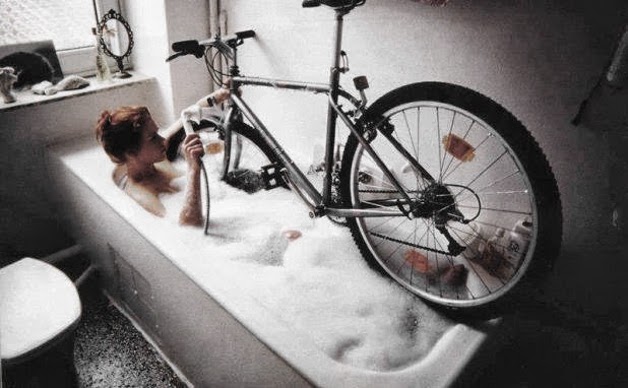What Kind of Biker Are you? Road or Mountain?
Let’s get one thing clear right away. When we say biker, the Hell’s Angel variety is off the table. We’re talking non-motorized here, people. And yes, there are all sorts. To name just a few:
The Pub crawl cruiser
The bike is the ideal means to get to the next bar faster.
You also like it to serve as a conversation piece when you saddle up
for the jaunt to the next watering hole. And, of course, you want to
look good riding it.
Ride: Main Street, out and back
Outfit: Sun dress, baggy shorts, flip flops. Don’t forget the perfect costume for Breck Cruisers.
Type of beer: You-Call-It
Money invested in gear: $50-$500
The Tandem
 You prefer to pedal when your honey’s bringing up the rear and when there are no super steep climbs or descents.
You prefer to pedal when your honey’s bringing up the rear and when there are no super steep climbs or descents.
Ride: Breck to Frisco and back on bike path.
Outfit: Brightly colored jerseys and socks (matching) and high quality spandex.
Type of beer: wine
Money invested in gear: $500 to $4,000
The weekend road warrior
Your days off are dedicated to getting your blood flowing
and your heart rate up via some semi-intense pedaling on the skinny
tires. Well, semi-intense for a few minutes at a time, anyway, with
plenty of photo breaks.
Ride: Breck to Keystone around the lake and back (unless the Summit Stage is calling your name at the high school).
Outfit: New Belgium jersey and mid-grade spandex purchased at REI
Type of beer: Fat Tire or Breckenridge Avalanche
Money invested in gear: $700-$3,000
The Casual mountain biker
The elevation gets to you when you grind in granny gear
for extended climbs, but you love the challenge of riding over obstacles
and through (shallow) creeks. Too many roots and rocks are a little
scary.
Ride: Flume Trails
Outfit: Baggy mountain bike shorts and not-too-tight jersey from Pearl Izumi or local outfitter.
Type of beer: Any IPA will do
Money invested in gear: $400 to $4,000
The Hard-core mountain biker
Those casual riders better MOVE when you’re rocketing down
the single track. Your ideal day is never seeing pavement. You carry at
least a gallon of water with you, rain jacket and at least two spare
tubes at all times. You can fix a flat in less than three minutes.
Ride: Flumes to Colorado Trail to West Ridge, down into
Keystone, back up through Summit Cove, down trailer park switchbacks to
Gold Hill and Peaks Trail back to Breck. Or out-and-back on the Wheeler
Trail.
Outfit: High-end baggy shorts or spandex with thick butt pad, long-sleeve jersey and full-finger gloves.
Type of beer: Stout or PBR
Money invested in gear: $3,000 to $10,000
USA Pro Cycling Challenge wannabe
If the pros can ride it, so can you. You think you could
probably take down some of the stragglers in that race if you had the
chance. You have ridden every stage of the Challenge and clock the Breck
time trial loop at least once a week, keeping meticulous track of the
seconds you shave off.
Ride: Anything marked with a Pro Cycling Challenge sign or anything involving at least 5,000 feet of climbing.
Outfit: Tight-fitting Euro brands, wraparound sports sunglasses.
Type of beer: Michelob Ultra
Money invested in gear: $8,000 to $20,000
The BMXer
You loving catching air in the skate park or over dirt jumps. The daily “grind” doesn’t get you down. After a long day at work, you hop on your bike and your buddies are skating behind you to have an evening at the parks. Heck, the streets obstacles are just as fun as the park. You usually find yourself bunny hopping around town.Ride: The Wellington Bike Park, the Breckenridge Skate Park or the streets in downtown Breck.
Outfit: Skinny jeans and t-shirt.
Type of beer: PBR or IPA
Money invested in gear: $500 to $1,200














